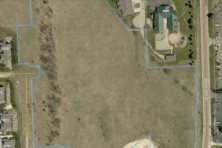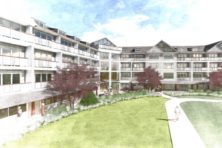46-unit Attainable Housing Project Proposed for Sister Bay
- Share
- Tweet
- Pin
- Share
Almost three years after a countywide study revealed a gap of more than 200 rental apartments in northern Door County, a new proposal for affordable units is on the table in Sister Bay.
Marissa Downs presented a broad-strokes plan to the Sister Bay Plan Commission in October for a 46-unit complex on 12.6 acres near the Northern Door Children’s Center. The one-story rental units would be available in one-, two- and three-bedroom floor plans with garages, individual entrances and rents between $332 and $800 per month.
Downs described the proposal as in the “very preliminary phase of development” and said it would depend on being awarded federal tax credits through the Wisconsin Housing and Economic Development Authority (WHEDA). Those credits come in exchange for providing housing at rents that are affordable for those making up to 80 percent of the county’s median household income.
For example, a single parent who has one child and earns less than $33,000 per year could rent a two-bedroom apartment for $730.
“When you’re talking about Section 42, the rent is derived based on your county’s median income,” Downs said. “There’s a base rent that anybody has to pay. It’s not a sliding scale based on your income. That difference is important to people who are opposed to people paying a percentage of income for rent.”
Plan Commission Chair Denise Bhirdo said if the development comes to fruition, it could be a “turning point for Sister Bay.” Bhirdo said the village has invested heavily in amenities for businesses and tourism, and it’s time to make an investment in the people who live there.
The apartments would be similar to the 24-unit Blackstone Harbor Apartments, which were built on Judith Blazer Drive in 2013 with support from WHEDA tax credits as well. Those units have operated at nearly 100 percent occupancy since construction was completed. Blackstone property manager Mary Kwaterski said there’s a need for more units such as those at the Blackstone, but there’s also a significant market gap they won’t fill.
She said she had one unit earmarked for a household making 60 percent of the median income that remained open for 10 months because people either made too little to afford the unit, or they made slightly too much to qualify to rent it.
“I went through so many applications and couldn’t get people into it,” she said. “It’s sad. It’s heartbreaking when I have to turn someone away.”
Blackstone has one two-bedroom apartment available at market rate of about $900 a month, and that’s always full, Kwaterski said.
Half of her renters are elderly, often single women in their 80s.
“Most of the people that call me are elderly,” Kwaterski said. “They want it, but if the rent increases, they can’t afford it. A lot of them literally don’t have anywhere to go. I have seniors that are living alone in a three-bedroom apartment because there’s nothing else available.”
A single mother with two kids who live on-site, Kwaterski also fields calls from a lot of families like her own that can’t afford homes but make too much to qualify for apartments at Blackstone.
“They need basic apartments at a lower price than what’s being built here,” she said. “We need something in that $800-$1,000 range without the income limits.”
But developers say the high cost of building in Door County – particularly the northern half of the peninsula – makes it difficult to fill the void. Only Sister Bay offers municipal sewer and water, and costs for labor and materials are higher than in the Fox Valley or Green Bay.
In Sister Bay, 36 units at Niagara Ridge were built four years ago, and another 48 units were completed this year at The Glen. Those units are all occupied today at rents of $1,275-$1,375.
“The demand is phenomenal,” said Cheryl Maggi-Novak of Premier Real Estate Management, which oversees the two complexes. She estimates that about half of her renters are working locals and half are retirees.
“Locals alone are having a hard time finding places,” Maggi-Novak said. “At least five people I’ve recently spoken to were renting houses where the owners turned them into vacation rentals.”
Downs speculates that the growing acceptance of remote work will squeeze lower-income people out of the housing market even more.
“If we stay in this place where we can work remotely, and live in a place like Door County, we could lose the supply of all of those other apartments as well,” she said.
To move forward with her project, Downs said she would need additional financial assistance from other sources beyond the tax credits. Building roads and hooking up to the sewer system could cost several hundred thousand dollars, she said. But Sister Bay officials may be hesitant to pick up the tab after getting burned by developer Keith Garot on projects that were never completed despite support from the village.
Garot had agreed to build a retention pond that would service the area where Stony Ridge and Downs’ proposal would go, but he never completed it.
Downs is optimistic she can get support for the project, and then it’s a waiting game. Tax credits are typically awarded in April or May.



